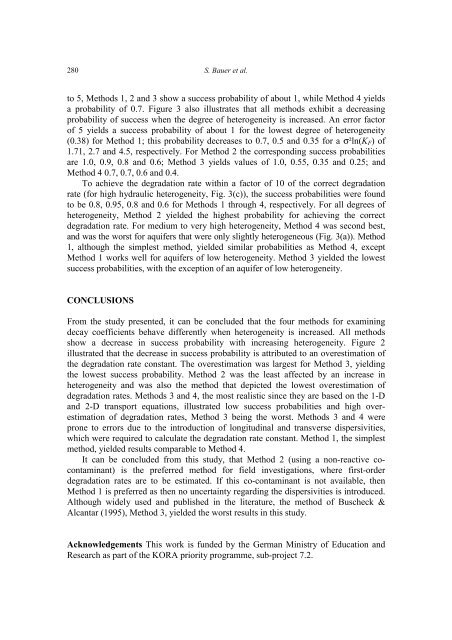Applied numerical modeling of saturated / unsaturated flow and ...
Applied numerical modeling of saturated / unsaturated flow and ...
Applied numerical modeling of saturated / unsaturated flow and ...
Create successful ePaper yourself
Turn your PDF publications into a flip-book with our unique Google optimized e-Paper software.
280<br />
S. Bauer et al.<br />
to 5, Methods 1, 2 <strong>and</strong> 3 show a success probability <strong>of</strong> about 1, while Method 4 yields<br />
a probability <strong>of</strong> 0.7. Figure 3 also illustrates that all methods exhibit a decreasing<br />
probability <strong>of</strong> success when the degree <strong>of</strong> heterogeneity is increased. An error factor<br />
<strong>of</strong> 5 yields a success probability <strong>of</strong> about 1 for the lowest degree <strong>of</strong> heterogeneity<br />
(0.38) for Method 1; this probability decreases to 0.7, 0.5 <strong>and</strong> 0.35 for a σ²ln(KF) <strong>of</strong><br />
1.71, 2.7 <strong>and</strong> 4.5, respectively. For Method 2 the corresponding success probabilities<br />
are 1.0, 0.9, 0.8 <strong>and</strong> 0.6; Method 3 yields values <strong>of</strong> 1.0, 0.55, 0.35 <strong>and</strong> 0.25; <strong>and</strong><br />
Method 4 0.7, 0.7, 0.6 <strong>and</strong> 0.4.<br />
To achieve the degradation rate within a factor <strong>of</strong> 10 <strong>of</strong> the correct degradation<br />
rate (for high hydraulic heterogeneity, Fig. 3(c)), the success probabilities were found<br />
to be 0.8, 0.95, 0.8 <strong>and</strong> 0.6 for Methods 1 through 4, respectively. For all degrees <strong>of</strong><br />
heterogeneity, Method 2 yielded the highest probability for achieving the correct<br />
degradation rate. For medium to very high heterogeneity, Method 4 was second best,<br />
<strong>and</strong> was the worst for aquifers that were only slightly heterogeneous (Fig. 3(a)). Method<br />
1, although the simplest method, yielded similar probabilities as Method 4, except<br />
Method 1 works well for aquifers <strong>of</strong> low heterogeneity. Method 3 yielded the lowest<br />
success probabilities, with the exception <strong>of</strong> an aquifer <strong>of</strong> low heterogeneity.<br />
CONCLUSIONS<br />
From the study presented, it can be concluded that the four methods for examining<br />
decay coefficients behave differently when heterogeneity is increased. All methods<br />
show a decrease in success probability with increasing heterogeneity. Figure 2<br />
illustrated that the decrease in success probability is attributed to an overestimation <strong>of</strong><br />
the degradation rate constant. The overestimation was largest for Method 3, yielding<br />
the lowest success probability. Method 2 was the least affected by an increase in<br />
heterogeneity <strong>and</strong> was also the method that depicted the lowest overestimation <strong>of</strong><br />
degradation rates. Methods 3 <strong>and</strong> 4, the most realistic since they are based on the 1-D<br />
<strong>and</strong> 2-D transport equations, illustrated low success probabilities <strong>and</strong> high overestimation<br />
<strong>of</strong> degradation rates, Method 3 being the worst. Methods 3 <strong>and</strong> 4 were<br />
prone to errors due to the introduction <strong>of</strong> longitudinal <strong>and</strong> transverse dispersivities,<br />
which were required to calculate the degradation rate constant. Method 1, the simplest<br />
method, yielded results comparable to Method 4.<br />
It can be concluded from this study, that Method 2 (using a non-reactive cocontaminant)<br />
is the preferred method for field investigations, where first-order<br />
degradation rates are to be estimated. If this co-contaminant is not available, then<br />
Method 1 is preferred as then no uncertainty regarding the dispersivities is introduced.<br />
Although widely used <strong>and</strong> published in the literature, the method <strong>of</strong> Buscheck &<br />
Alcantar (1995), Method 3, yielded the worst results in this study.<br />
Acknowledgements This work is funded by the German Ministry <strong>of</strong> Education <strong>and</strong><br />
Research as part <strong>of</strong> the KORA priority programme, sub-project 7.2.

















